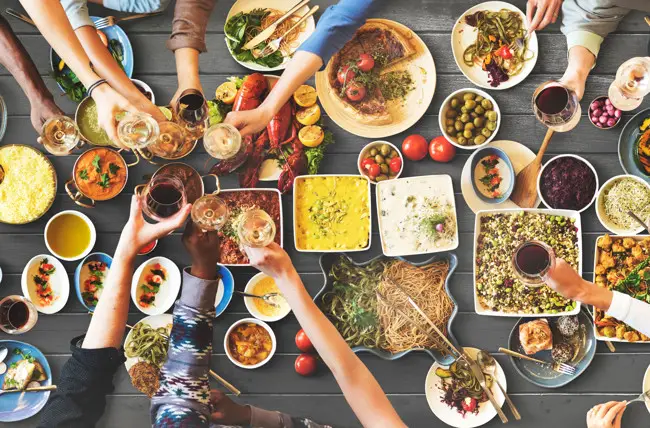—Six-year-old Mia dutifully stuffs down dinner, then munches on handfuls of Cheerios until she is so full, she falls asleep. In the morning, she refuses breakfast
—At dinner, Lindsay’s parents hide their 10-year-old daughter’s small portion of chicken under a pile of pasta. “No way,” she says, discovering it. “This thing once had eyes!”
—Justin, 9, a cranky carnivore, wants only hamburgers. He has a fit if anything green touches his plate. His father enthusiastically piles his plate with veggies. “These are great, Justin. Try some.”

How can parents deal with mealtime battles? We can run away from home, react by putting more pressure on our kids’ eating . . . or we can respond by supporting and encouraging kids to make their own choices about what to eat, when to eat and how much to eat.
Sixty years ago, Dr. Spock rocked every mother’s world when he announced that infants could self-regulate their food intake and should not be fed on a schedule, but on demand. He contended that babies instinctively knew the right amount of milk they needed and that this was usually the amount necessary to promote optimal growth.
So why, as our children grow up, do we stop trusting their nutritional instincts? Because as infants grow into children and reach for options beyond bottle, left or right breast, we get nervous. They demand Happy Meals, refuse milk, fuss and whine over every meal — and we panic. What if they don’t eat lunch at noon, or ingest three perfectly balanced meals a day? We don’t want our kid to be another obesity statistic or become anorexic. To ensure their health and well being, we step in, restricting, monitoring and scheduling their meals. By the time they start school, too many kids have lost touch with their innate biological cues. They confuse I want to eat (which is appetite or mouth hunger and usually connected to emotion and stress) with physical belly hunger meaning, I need to eat.
We can help our children reconnect by encouraging them to eat in response to their internal, physical cues of hunger and satiation without restricting food based on our notions of “right” or “wrong”. This process, now known as “Intuitive Eating”, asks that instead of exerting more control to get our kids’ eating where we think it should be, we stop applying pressure. We return the job of self-regulating to our kids.
Dozens of studies confirm the benefits of “Intuitive Eating”. Research published in The New England Journal of Medicine over a decade ago reported that given free reign, kids’ average eating — not in a single meal but over several days — is nutritious and well balanced. Their eating may look random, but if allowed to choose, children will consume calories according to their physical as well as nutritional needs.
Interestingly, without fear that food will be taken away, with nothing to rebel against, kids begin to listen to their bodies. They notice that eating candy 24/7 gives them headaches or makes them feel queasy. Little and big athletes see that yogurt or a banana sustains their energy longer than cookies. Some learn to appreciate that their stomachs can’t handle too much fiber, or that meat does not digest well in their systems. The truth is, most of us, including kids, feel better eating cleaner, healthier foods.
HOW TO RETURN YOUR KIDS TO INTUITIVE EATING
1. Identify hunger. Ask: Are you hungry? Ask every time you see your child reaching for food. “Are you hungry in your tummy? Is your tummy growling, gurgling, empty?” (or whatever language is age-appropriate). If you think your child is eating for reasons other than hunger, rather than challenge their impulse to eat, simply offer some other possibilities: Would you like chips, or to read a book, take a walk, watch a movie?
2. Eat the foods that “hum” to your body. Help kids clarify by asking: Do you want salty or sweet, hot or cold, crunchy or creamy? Avoid categorizing selections into “good” and “bad” foods. Allow all foods to have equal power and charge. No food is forbidden.
3. Eat with pleasure and attention. Eat slowly. Chew well. The goal is to eat until comfortably satisfied or satiated. Suggest kids imagine that their stomach is a glass filled 2/3 with water. There’s empty space. They could walk with the glass and it wouldn’t spill.
4. Eating is a natural biological process, like going to the bathroom. When we understand the physical cue, and then respond appropriately, we don’t need to think about food or eating all the time. When hungry, we select what we want and eat until we are satiated. Then we move on. Without guilt or worry. When hunger comes again, we repeat.
Intuitive Eating is a journey best taken by parents and children together. It’s not meant to be a free-for-all. Parents can and should set limits. Veto soda, or set limits on how many snacks a child may keep in the house, perhaps allowing one favorite salty and one favorite sweet snack from pre-portioned 100-calorie snack packs. What about mealtimes? Everyone may not be hungry at the same time, but meeting times can still be established where everyone sits at the table together to enjoy family time.
Intuitive Eating has many benefits. It creates self-confidence and self-esteem. It promotes self-trust as children become their own authority; it allows kids to learn healthy boundaries as they say yes and no to food appropriately. It promotes normal weight while encouraging enjoyment of all foods, removes urges to diet, and teaches kids how to take care of feelings and stress without food. It removes food fears and obsessions. Intuitive Eating returns joy and pleasure to meals and allows food to occupy its appropriate place in life. If we teach kids how to eat and don’t pressure them with rules to rebel against, they will be happier and healthier for life.
SUSAN WEISS BERRY, M.S., C.N.S. is a Certified Nutrition Specialist in private practice on the Upper East Side. Former Director of the Center for Nutrition and Wellness, she has been teaching Natural (Intuitive) Eating to individuals, families and corporations since 1978. She can be reached at [email protected].





















